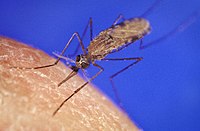
Photo from wikipedia
Many species of Anopheles mosquitoes exist as part of species complexes; that is groups of very closely related species. A prime example of this is the Anopheles gambiae s.l. species… Click to show full abstract
Many species of Anopheles mosquitoes exist as part of species complexes; that is groups of very closely related species. A prime example of this is the Anopheles gambiae s.l. species complex, which comprises at least 9 species, including three of the most important malaria vectors in sub-Saharan Africa: An. gambiae s.s., An. coluzzii and An. arabiensis. Despite widespread and extensive sampling of An. gambiae s.l. in Africa it is remarkable that in 2019 a new member of the complex, An. fontenillei, has been described [1]. This species was collected in Gabon, and cytogenetic and genetic analysis places it as a close relative of An. bwambae, a geographically restricted species found only in hot springs in Uganda more than 2,000 kilometers away. The next closest relative was ambiguous; either the important vector An. arabiensis, or the non-vector species An. quadriannulatus. So far there is no evidence that this new species is a malaria vector. However, the authors also used whole genome analysis to uncover evidence of recent introgression of adaptive genes between the new species and An. gambiae/coluzzii, including some involved in vectoral capacity. In the past, the relationship between the species of the An. gambiae complex has been notoriously difficult to determine, but recently the availability of reference genomes of some species has provided new opportunities. Fontaine et al. [2], was able to confidently determine the correct branching order of the species tree, and to infer past introgression between An. gambiae/ coluzzii and An. arabiensis, and between An. merus and An. quadriannulatus. Both of these recent studies acknowledge that teasing apart the different evolutionary processes of past introgression, present gene flow and incomplete lineage sorting is still a major challenge for the An. gambiae species complex. We know that in the laboratory all studied An. gambiae s.l. species will cross-mate and produce viable eggs [see [3], and refs therein]. But what happens in nature is still unclear. Some species (An. melas, An. merus, An. quadriannulatus, An. amharicus and An. bwambae) do not overlap in their distributions, so will never meet and mate, and there are premating barriers between other species (e.g. [4]). However, two species (An. gambiae and An. coluzzii) do hybridize frequently in the wild, and there is also some evidence from genetic markers of rare (<0.1%) wild hybrids between other sympatric species. The study of the genomes of mosquito species has important applications, such as identifying genes responsible for vectoral capacity, managing insecticide resistance, and more recently, for predicting the spread of transgenes that may be implemented for malaria control. We may gain more ability to resolve the different processes when we have genomic data from wild-caught samples. So far, availability of population genomic data has mostly been confined to An. gambiae s.s. and An. coluzzii (the Anopheles gambiae 1000 Genomes Project [5]), but sequencing efforts are now expanding to more species and locations. We now have the ability to generate huge amounts of genetic data with falling costs; it is clearly important that capacity is also available for continued and widespread sampling of mosquitoes from wild settings. At the time of writing, there is a report of yet another new species of An. gambiae s.l. from Burkina Faso (D. Neafsey, Personal Communication); it will be intriguing to see what new insights the study of this species will bring.
Journal Title: Pathogens and Global Health
Year Published: 2020
Link to full text (if available)
Share on Social Media: Sign Up to like & get
recommendations!